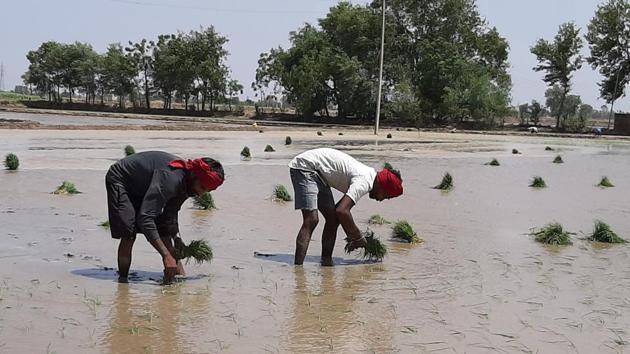Crisis looms as Moga water table going down a metre every year
The water recharging process in all five blocks in Punjab’s Moga district is moving at a very slow pace and, according to official records, the water table is depleting at a rate of one metre every year.
With farmers adamant on sowing paddy in their fields, Moga is staring at a water crisis due to the depleting groundwater level.

All the five blocks in the district — Moga-1, Moga-2, Baghapurna, Nihal Singh Wala and Kot Ise Khan — are in the dark zone with regard to groundwater resources. The water recharging process is moving at a very slow pace and, according to official records, the water table is depleting at a rate of one metre every year.
Despite tall claims of the Punjab government and its campaigns to convince farmers against paddy cultivation, the water-guzzling crop is likely to be sown in around 93% of 1.94 lakh hectares of cultivable land. Non-paddy crops are likely to be cultivated in only 2,700 hectares of land in the district this year.
“Last year paddy was sown in 1.80 lakh hectares of land. This year, we are hopeful of bringing 2,500 hectares of land under maize and 200 hectares of land under cotton cultivation. Our officers are regularly visiting villages to encourage farmers to sow non-paddy crops, but they are not showing interest. Farmers are firm on sowing paddy in more than 1.77 lakh hectares of land,” said Paramjit Singh Brar, chief agriculture officer, Moga.
Merely 4,800 hectares (2%) land under paddy cultivation was likely to be irrigated through Sirhind feeder and Abohar canal while 98% would draw water from tube wells, said an agriculture department official..
In a majority of villages, the water table has depleted to around 300 to 500 feet from 200 feet earlier. The decline in groundwater is compelling farmers to install more tubewells to extract the required water. “Most of the wells in the district have gone dry and farmers are digging deeper to extract water from beneath. The groundwater level is dipping at an alarming level,” said Sandeep Walia, an official in the hydro-geological wing of agriculture department.
‘Not enough support from government’
The farmers claimed that despite making big promises, the state government had failed to offer required help to switch over to other crops. There was a huge price gap between paddy and maize, they said.
“The government is asking us to shift to maize cultivation but there is no dryer available in the district. In the non-availability of dryers, the quality of our crop deteriorates as it takes longer to get it dry. The government does not buy the crop, so we have to sell it to traders on lower price,” said Ranjit Singh, a farmer of Dhurkot .






